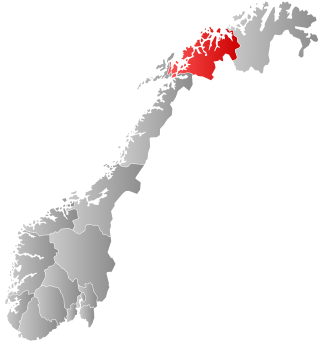
Tranøy is a former municipality in Troms county, Norway. The municipality was situated on the southern coast of the large island of Senja. The municipality existed from 1838 until its dissolution in 2020 when it was merged into the new Senja Municipality. The administrative centre was the village of Vangsvik in the eastern part of the municipality. Other important villages included Stonglandseidet, Skrollsvika, and Å.

Torsken is a former municipality that was located on the western coast of the large island of Senja in Troms county, Norway. The municipality existed from 1902 until its dissolution in 2020 when it was merged into the new Senja Municipality. The administrative centre of the municipality was the village of Gryllefjord. Other larger villages in Torsken Municipality included the villages of Torsken, Medby, and Flakstadvåg.

Berg is a former municipality in Troms county, Norway. The municipality existed from 1838 until its dissolution in 2020 when it was merged into the new Senja Municipality. The administrative centre of the municipality was the village of Skaland. Other villages included Finnsæter, Mefjordvær, and Senjahopen. The municipality was located on the western part of the large island of Senja.

Lenvik is a former municipality in Troms county, Norway. The municipality existed from 1838 until its dissolution in 2020. The municipality was partly situated on the mainland and partly on the island of Senja in what is now Senja Municipality. The administrative centre was the town of Finnsnes, where the Gisund Bridge connects Senja to the mainland on Norwegian County Road 86. Other villages in the municipality included Aglapsvik, Gibostad, Botnhamn, Fjordgård, Finnfjordbotn, Husøy, Langnes, Laukhella, Silsand, and Rossfjordstraumen.
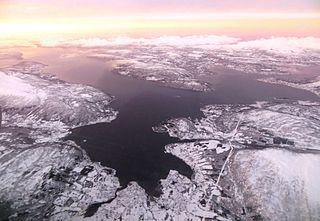
Senja (Norwegian) or Sážžá (Northern Sami) is an island in Senja Municipality in Troms county, Norway in northern Europe. With an area of 1,586.3 square kilometres (612.5 sq mi), it is the second largest island in Norway. It has a wild, mountainous outer (western) side facing the Atlantic, and a mild and lush inner (eastern) side. The island is located within Senja Municipality, which was established on 1 January 2020. The island of Senja had 7,864 inhabitants as of 1 January 2017. Most of the residents live along the eastern coast of the island, with Silsand being the largest urban area on the island. The fishing village of Gryllefjord on the west coast has a summer-only ferry connection to the nearby island of Andøya: the Andenes–Gryllefjord Ferry.
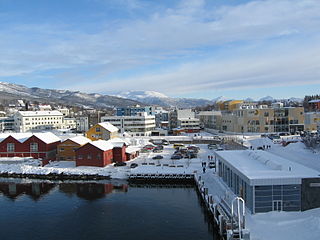
Finnsnes is a small town that is the administrative centre of Senja Municipality in Troms county, Norway. The town is located on the mainland part of Norway, just across the Gisundet strait from the island of Senja. The Gisund Bridge connects Finnsnes to the suburban villages of Silsand and Laukhella on the island of Senja. The municipality is well-provided with kindergartens and a decentralized school system on both primary and secondary levels. There are also three schools on the upper secondary/high school level and a center for decentralized studies at the university level. Finnsnes Church is located in the center of the town.

Gryllefjord is a fishing village in Senja Municipality in Troms county, Norway. It is located on the island of Senja, along the Gryllefjorden in the northern part of the municipality. The 0.25-square-kilometre (62-acre) village has a population (2017) of 383 which gives the village a population density of 1,532 inhabitants per square kilometre (3,970/sq mi).
Kvaløya is the name of many islands in Norway:
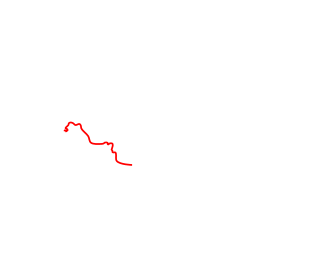
County Road 86 is a 110-kilometre-long (68 mi) highway in Troms county, Norway. The eastern end of the road begins in the village of Andselv. It then heads west to the Gisund Bridge connecting the mainland of Norway to the large island of Senja. The road then heads across the island of Senja to the village of Torsken on the western coast of Senja Municipality. Part of the route is one of eighteen designated National Tourist Routes in Norway.

Skipsfjorden is a branch of the Torskenfjorden in Senja Municipality on the western coast of the large island of Senja in Troms county, Norway.
Tranøy or Tranøya may refer to:
Medby Chapel is a chapel of the Church of Norway in Senja Municipality in Troms county, Norway. It is located in the village of Medby on the west coast of the island of Senja. It is an annex chapel for the Torsken parish which is part of the Senja prosti (deanery) in the Diocese of Nord-Hålogaland. The white, wooden chapel was built in a long church style in 1937. The chapel seats about 170 people.
Flakstadvåg Chapel is a chapel of the Church of Norway in Senja Municipality in Troms county, Norway. It is located in the village of Flakstadvåg on the west coast of the island of Senja. It is an annex chapel for the Torsken parish which is part of the Senja prosti (deanery) in the Diocese of Nord-Hålogaland. The white, wooden chapel was built in a long church style in 1925 by an unknown architect. The chapel seats about 150 people.

Torsken Church is a parish church of the Church of Norway in Senja Municipality in Troms county, Norway. It is located in the village of Torsken on the west coast of the island of Senja. It is the main church for the Torsken parish which is part of the Senja prosti (deanery) in the Diocese of Nord-Hålogaland. The red, wooden church was built in a cruciform style in 1784 by an unknown architect. The church seats about 100 people.

Gryllefjord Chapel is a chapel of the Church of Norway in Senja Municipality in Troms county, Norway. It is located in the village of Gryllefjord on the west coast of the island of Senja. It is an annex chapel for the Torsken parish which is part of the Senja prosti (deanery) in the Diocese of Nord-Hålogaland. The white, wooden chapel was built in a long church style in 1938 by renovating an older building that was constructed in 1902 by an unknown architect. The chapel seats about 150 people.

Torsken is a village in Senja Municipality in Troms county, Norway. It is located along the Torskenfjorden on the southwestern part of the island of Senja. The Skipsfjorden branches off the main fjord just east of the village. The historic Torsken Church is located in this village. There is one road into the village, from the municipal centre of Gryllefjord.

Medby is a village in Senja Municipality in Troms county, Norway. It is located along the Veidmannsfjorden on the southwestern part of the island of Senja. The village lies along a highway that connects the villages of Grunnfarnes and Sifjord. The Kaldfarnes area lies just to the west of Medby and Ånderdalen National Park lies about 5 kilometres (3.1 mi) to the east of the village. Medby Chapel is located in this village.
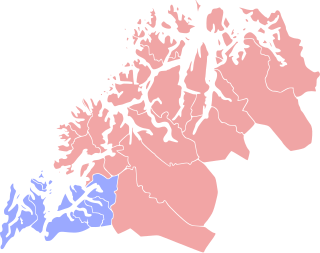
Senja District Court was a district court located in the town of Finnsnes in Troms county, Norway. The court served the central and southeastern part of the county which included the municipalities of Bardu, Berg, Dyrøy, Lenvik, Målselv, Torsken, Tranøy, and Sørreisa. The court was subordinate to the Hålogaland Court of Appeal. The court was led by the chief judge Frank Kjetil Olsen. This court employed a chief judge and two other judges.

Senja is a municipality in Troms county, Norway. It was established on 1 January 2020 when the municipalities of Berg, Lenvik, Torsken, and Tranøy were merged into one municipality. It is located in the traditional district of Hålogaland. The administrative centre of the municipality is the town of Finnsnes. The municipality includes all of the island of Senja, the smaller surrounding islands, and part of the mainland between the Gisundet strait and the Malangen fjord.











